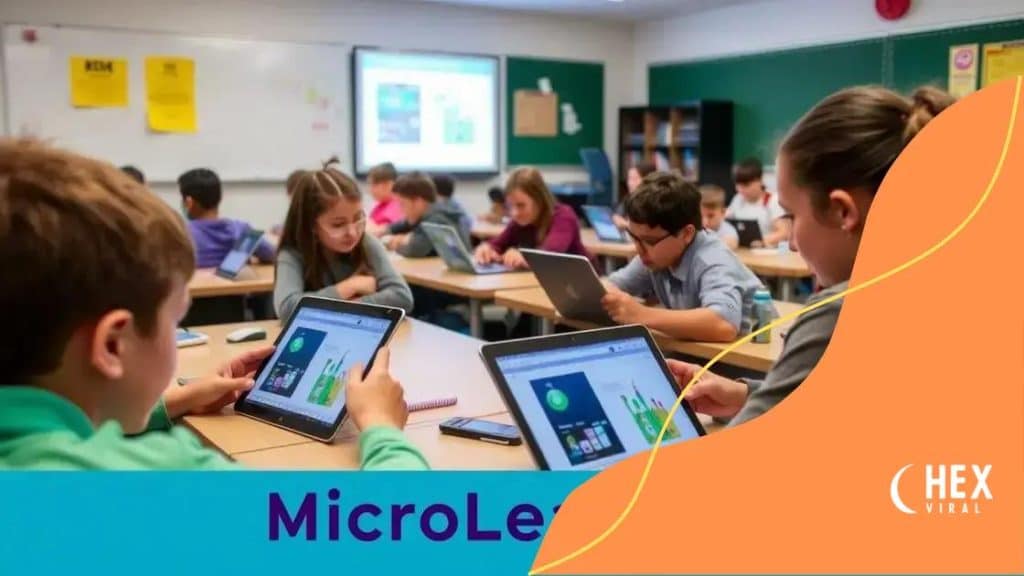The rise of microlearning: transforming education with bite-sized lessons

Microlearning is an educational approach that delivers content in small, focused segments, enhancing learner engagement and retention across various fields such as corporate training and education.
The rise of microlearning is changing the landscape of education, making it easier for learners to absorb knowledge in smaller, manageable chunks. Have you ever wondered how this approach can fit into your busy schedule? Let’s dive in.
Understanding microlearning and its significance
Understanding microlearning is crucial in today’s fast-paced world. This approach to education focuses on delivering content in small, digestible units. It enables learners to grasp concepts more effectively without feeling overwhelmed.
Microlearning is not just about breaking content into smaller parts; it’s about making learning more accessible and engaging. For instance, a quick five-minute video or a short interactive quiz can reinforce what students have learned in longer sessions.
The significance of microlearning
There are several reasons why microlearning has gained popularity:
- Convenience: Learners can access content anytime and anywhere.
- Flexibility: It fits easily into busy schedules, allowing people to learn at their own pace.
- Engagement: Short, focused lessons can keep learners more interested.
- Retention: Information presented in bite-sized pieces is easier to remember.
Implementing microlearning in educational settings can lead to substantial improvements in knowledge retention. When learners are exposed to short bursts of information, they can process it better and find connections between concepts.
Incorporating multimedia elements, such as videos, infographics, and interactive quizzes, makes microlearning even more effective. These tools cater to different learning styles, offering a rich educational experience.
As we continue to explore the possibilities, it’s clear that microlearning is more than just a trend; it’s a significant advancement in how we think about education today.
The advantages of bite-sized lessons in education
Bite-sized lessons in education offer substantial benefits that cater to modern learning needs. These short and focused lessons enable students to absorb information without feeling overwhelmed.
One of the key advantages of bite-sized lessons is their ability to enhance retention. When content is divided into smaller, more manageable portions, learners can better remember and recall the information later. This method aligns with how our brains naturally process information.
Benefits of bite-sized lessons
Here are some of the primary advantages:
- Improved engagement: Short lessons maintain learner interest and motivate participation.
- Time efficiency: Learners can fit lessons into their busy schedules, allowing for better time management.
- Flexible learning: Bite-sized modules can be accessed anytime, anywhere, promoting self-paced learning.
- Diverse learning styles: Various multimedia elements can be integrated to suit different preferences, enhancing overall understanding.
Incorporating bite-sized lessons fosters a more personalized educational experience. As each learner progresses at their own pace, they can revisit materials anytime, reinforcing their understanding.
Additionally, these lessons can be easily adapted to different subjects, making them applicable in virtually any learning environment. From language acquisition to technical skills, bite-sized lessons can provide a framework that encourages continuous learning and development.
As we see a shift towards more flexible and personalized education, embracing the concept of bite-sized lessons can greatly enhance the learning process for students of all ages.
Effective strategies for implementing microlearning

Implementing microlearning effectively requires thoughtful strategies that ensure content is relevant and engaging. These strategies can help educators create a more dynamic learning environment.
One effective approach is to leverage multimedia content. Incorporating videos, infographics, and interactive quizzes can enhance understanding and retention. When microlearning is diverse, it caters to different learning styles, making it more appealing to a wide range of students.
Key strategies for successful implementation
Consider these strategies when introducing microlearning:
- Define clear learning objectives: Focus on specific outcomes for each module to guide your content.
- Keep it short and focused: Limit each lesson to 5-10 minutes to maintain learner attention.
- Utilize technology: Use learning management systems (LMS) or apps for easy access to materials.
- Encourage feedback: Allow learners to share their thoughts to improve content and engagement.
Another important aspect is to make lessons easily accessible. Offering modules in a format that learners can use on-the-go ensures they can engage with the content when it’s convenient for them. This flexibility enhances the overall learning experience.
Incorporating regular assessments can also reinforce learning. Short quizzes at the end of each microlearning module allow instructors to gauge student understanding and adjust future lessons accordingly. This ensures that learners are not just passive recipients of information but active participants in their educational journey.
Finally, continuously evaluate and refine your microlearning approach. Collecting data on learner performance can provide insights into what works best and where improvements can be made, ensuring the strategies you employ remain effective over time.
Tools and platforms for microlearning delivery
Choosing the right tools and platforms for microlearning delivery is crucial for effective education. With many options available, educators can enhance the learning experience significantly.
One popular tool is a Learning Management System (LMS). LMS platforms provide a centralized location for learners to access courses, track progress, and engage with content. These systems often include features like gamification and assessments that make microlearning more interactive.
Popular tools for microlearning
Here are some effective tools to consider:
- Edmodo: A platform ideal for sharing resources, facilitating discussions, and managing assignments.
- Quizlet: Best for creating interactive flashcards and quizzes that help reinforce concepts.
- Google Classroom: This tool enables easy sharing of short lessons, assignments, and feedback between teachers and students.
- Articulate Rise: An authoring tool that allows the creation of responsive learning modules quickly and intuitively.
Another effective strategy is to incorporate mobile learning apps. With the increasing prevalence of smartphones, mobile apps allow learners to access content anytime and anywhere. This access supports the idea of learning in small doses, which is a core principle of microlearning.
Additionally, using social media platforms can enhance microlearning. Educators can share bite-sized content through platforms like Twitter or Facebook, promoting engagement and discussion among learners.
Interactive video platforms also provide opportunities for effective microlearning delivery. Videos can include quizzes or polls, keeping learners actively involved while conveying essential information in a condensed format.
By leveraging these tools and platforms, educators can create a more dynamic and engaging experience for learners. An effective mix of technologies not only supports the principles of microlearning but also augments learners’ understanding and retention of the material.
Real-world examples of microlearning in action
Real-world examples of microlearning illustrate how this approach can transform education and training. These cases demonstrate the flexibility and effectiveness of learning in smaller, bite-sized formats.
One notable example is how companies use microlearning for employee training. For instance, a large tech firm implemented short video tutorials that employees could access on their mobile devices. This allowed them to learn new software features quickly without interrupting their workflow.
Successful microlearning implementations
Here are a few examples of effective microlearning in action:
- Duolingo: This language-learning app offers concise lessons that users can complete in just a few minutes, making language acquisition fun and engaging.
- Salesforce: The company uses bite-sized training modules to help employees quickly grasp new sales tools and processes, ensuring they stay current.
- TED-Ed: This platform provides short, educational videos on a variety of topics, allowing students to learn something new in only a few minutes.
- LinkedIn Learning: This program offers brief courses and tutorials on professional skills, enabling users to gain knowledge quickly and efficiently.
In educational settings, some universities have adopted microlearning strategies by creating short, animated videos that explain complex concepts. This method helps students grasp challenging material without spending hours on lengthy lectures.
Additionally, nonprofits are leveraging microlearning to train volunteers. They provide short e-learning modules that cover essential topics, enabling volunteers to learn at their own pace before they start their work.
Overall, these real-world examples show that microlearning is not just a trend but an effective method for various learning environments. By breaking down information into manageable pieces, organizations can enhance understanding, retention, and engagement among learners.
In conclusion, microlearning is a powerful educational approach that offers many advantages. By delivering information in small, bite-sized portions, it enhances engagement and retention. Real-world examples from various fields show how effective microlearning can be for both learners and organizations. With the right tools and strategies, this form of learning can create a more personalized and flexible educational experience. As we embrace technology and adapt to the evolving landscape of education, microlearning will continue to play a vital role in helping learners succeed.
FAQ – Frequently Asked Questions about Microlearning
What is microlearning?
Microlearning is an educational approach that delivers content in small, focused segments, making it easier for learners to absorb and retain information.
How does microlearning improve engagement?
By breaking content into short lessons, microlearning keeps learners interested and motivated, allowing for more interactive and enjoyable experiences.
What are some effective tools for microlearning?
Tools such as Learning Management Systems (LMS), mobile apps, and platforms like Duolingo and Quizlet are great for delivering microlearning content.
Can microlearning be applied in various fields?
Yes, microlearning can be effectively used in education, corporate training, healthcare, and many other fields, adapting to the needs of diverse learners.






